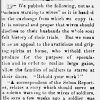calsfoundation@cals.org
Thirty-Seventh (Bell's) Arkansas Infantry (CS)
The Thirty-seventh Arkansas Infantry Regiment was a Confederate unit that served in the Trans-Mississippi Theater during the American Civil War. It was a volunteer regiment, as it was organized in March 1862, prior to the enactment of the 1862 Confederate Conscript Law. It was composed primarily of men from Ashley, White, Woodruff, Union, Dallas, Clark, and Benton counties. The original command staff consisted of Colonel Joseph C. Pleasants, Lieutenant Colonel John A. Geoghegan, and Major Samuel S. Bell.
Initially referred to as the First Trans-Mississippi Infantry Regiment and designated as the Twenty-ninth Arkansas Infantry by the Confederate War Department, it was most commonly referred to as Pleasant’s [sic] Arkansas Infantry. After the Battle of Prairie Grove and reorganization of the regiment, the War Department mistook it for a new regiment, designating it as the Thirty-seventh Arkansas Infantry. Major Bell was promoted colonel to fill the vacancy caused by Colonel Pleasants’s death.
During the summer and fall of 1862, the regiment remained in central Arkansas before marching to northwestern Arkansas to defend against invading Union forces led by Brigadier General Francis Herron. As part of Brigadier General James Fagan’s brigade, the regiment saw its first fighting on December 7, 1862, at the Battle of Prairie Grove. In the initial advance by the Federals, a Confederate artillery battery was overrun, but the Confederates charged the enemy, driving them back into the prairie. The slaughter was great. In the heavy action along the ridge near the Borden House and into the prairie, the Thirty-seventh lost forty-two killed and mortally wounded, forty-seven wounded, and one captured. It returned to central Arkansas and established winter quarters near Little Rock (Pulaski County).
On July 4, 1863, the Thirty-seventh Arkansas participated in the Battle of Helena. Fagan’s brigade was tasked with attacking Battery D, the southernmost of four Union positions along the hills west of the town. Due to confusion in other brigades regarding when to attack, Fagan launched the attack alone at sunrise as ordered. Bell and the Thirty-seventh went forward, along with Hawthorne’s regiment, and the Federal artillery in Battery C and Fort Curtis immediately opened a devastating fire on their ranks. Hawthorne and Bell managed to take four of the five lines of rifle pits as they struggled toward the Union position in extreme heat and over rugged terrain. Casualties were extremely high, and as Confederates’ advance faltered, Union forces counterattacked, cutting off many of Bell’s and Hawthorne’s survivors and capturing them en masse, including Colonel Bell. The Confederate forces failed to take the city, eventually retreating back to Little Rock. In the fighting at Battery D, the Thirty-seventh lost fourteen killed, seventeen wounded, and 191 missing or captured.
For the next month, the regiment served at various locations along the White River as part of Fagan’s brigade until Federal forces began their advance on Little Rock. During the initial cavalry battles of August 1863, Confederate infantry, including the Thirty-seventh, held strong works east of the city and north of the Arkansas River. When Union cavalry successfully forded the Arkansas River below Little Rock on September 10, 1863, the infantry withdrew through Little Rock, retreating to Arkadelphia (Clark County) and giving up the state capital to the enemy.
The Thirty-seventh Arkansas garrisoned at Camden (Ouachita County) until April 1864 as part of Brigadier General Alexander Hawthorne’s brigade. They were ordered to northern Louisiana to assist in the defense against Union forces during the Red River Campaign. Before they could arrive, Confederate forces fought at Pleasant Hill and Mansfield, Louisiana, causing Major General Nathaniel Banks and his Union forces to retreat. The entire Confederate army then turned north to assist Major General Sterling Price and his cavalry in defending against Major General Frederick Steele’s column out of Little Rock, attempting to unite with Banks.
The Thirty-seventh Infantry’s final battle was April 30, 1864, at Jenkins’ Ferry on the Saline River. As part of Hawthorne’s Brigade, the regiment charged in the first wave and was pinned down in a water-filled swale in the middle of a muddy cornfield. Here, it fought fiercely until heavy casualties resulted in orders to withdraw. No reports from any of Hawthorne’s regiments were submitted, resulting in no casualty or after-action reports.
The remnant of the regiment saw no fighting for the remainder of the war and was stationed at Marshall, Texas, when General Kirby Smith surrendered the department on May 26, 1865. Ordered to Shreveport, Louisiana, to receive their paroles, the regiment did not report but simply disbanded without formally surrendering. Most individually journeyed to their homes, receiving their paroles at various locations along the way.
For additional information:
Bearss, Edwin C. Steele’s Retreat from Camden and the Battle of Jenkins’ Ferry. Little Rock: Pioneer Press 1967.
Richards, Ira Don. “The Battle of Jenkins’ Ferry.” Arkansas Historical Quarterly 20 (Spring 1961): 3–16.
Shea, William. Fields of Blood: The Prairie Grove Campaign. Chapel Hill: University of North Carolina Press, 2009.
Anthony Rushing
Benton, Arkansas







Comments
No comments on this entry yet.